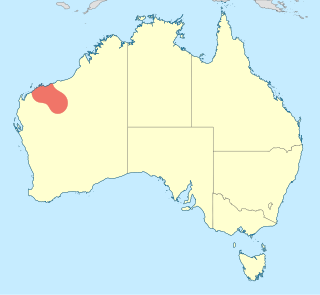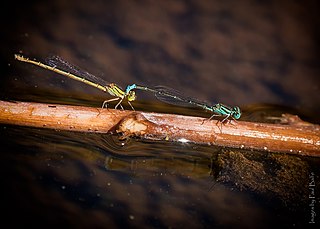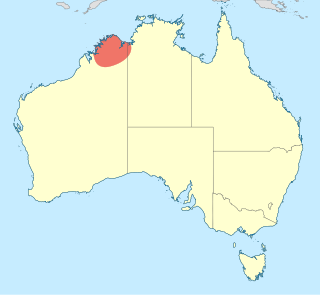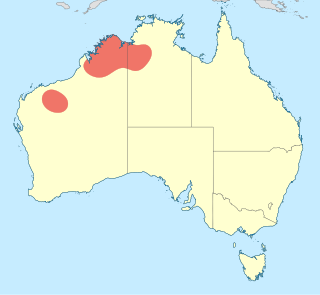
The tau emerald is a species of dragonfly in the family Corduliidae. It is found in all parts of Australia except northern Queensland and north-western Western Australia. The species was first described by Edmond de Sélys Longchamps in 1871.

The Australian emerald is a species of dragonfly in the family Corduliidae. It can be found in Australia, Lord Howe Island, Norfolk Island, Lesser Sunda Islands and New Zealand. It is a small to medium-sized, long-legged dragonfly coloured black-metallic and yellow. In both males and females the inboard edge of the hindwing is rounded.

Hemicordulia continentalis is a species of dragonfly in the family Corduliidae, known as the fat-bellied emerald. It inhabits pools, lakes, ponds and swamps in coastal Queensland and northern New South Wales, Australia.

Hemicordulia flava is a species of dragonfly in the family Corduliidae, known as the desert emerald. It inhabits still pools in Central Australia.

Hemicordulia intermedia is a species of dragonfly in the family Corduliidae, known as the yellow-spotted emerald. It inhabits slow flowing rivers, lagoons and ponds across northern Australia.

Hemicordulia kalliste is a species of dragonfly in the family Corduliidae, known as the slender emerald. It is uncommon and has been found in both Arnhem Land and Cape York, Australia.

Hemicordulia superba is a species of dragonfly in the family Corduliidae, known as the superb emerald. It inhabits rivers, pools and lakes in south-eastern Queensland and northern New South Wales in Australia.

Austrogomphus gordoni, also known as Austrogomphus (Xerogomphus) gordoni, is a species of dragonfly of the family Gomphidae, commonly known as the western red hunter. It inhabits streams and pools in Western Australia.

Antipodogomphus hodgkini is a species of dragonfly of the family Gomphidae, known as the Pilbara dragon. It is endemic to the Pilbara region of Western Australia, where it inhabits rivers, streams and pools.

Hemigomphus magela is a species of dragonfly of the family Gomphidae, known as the Kakadu vicetail. It is a small, black and yellow dragonfly, endemic to Northern Territory, Australia, where it inhabits streams.

Nannophlebia injibandi is a species of dragonfly of the family Libellulidae, commonly known as the Pilbara archtail. It inhabits streams and rivers of northern Australia. It is a small dragonfly with black and yellow markings and a slender body.

Ictinogomphus dobsoni is a species of dragonfly in the family Lindeniidae which was formerly part of the family Gomphidae, and known as the Pilbara tiger. It is a medium to large, black dragonfly with yellow markings and clear wings. Ictinogomphus dobsoni is endemic to the Pilbara region in Western Australia, where it inhabits rivers, lakes and ponds.

Agriocnemis kunjina is a species of Australian damselfly in the family Coenagrionidae, commonly known as a Pilbara wisp. It is a small damselfly, endemic to the Pilbara region in Western Australia, where it inhabits still and flowing water.

Austroagrion pindrina is a species of damselfly in the family Coenagrionidae, commonly known as a Pilbara billabongfly. It is a small damselfly; the male is blue and black. It is endemic to the Pilbara region of Western Australia, where it inhabits streams and still waters.

Eurysticta coolawanyah is a species of damselfly in the family Isostictidae, commonly known as a Pilbara pin. It is endemic to the Pilbara region in Western Australia, where it inhabits pools in rivers.

Archiargiolestes parvulus is a species of Australian damselfly in the family Megapodagrionidae, commonly known as a midget flatwing. It is endemic to south-western Australia, where it inhabits streams, bogs and swamps.

Nososticta pilbara is a species of Australian damselfly in the family Platycnemididae, commonly known as a Pilbara threadtail. It has only been found in the Pilbara region of Western Australia, where it inhabits streams and pools.

Nososticta kalumburu is a species of Australian damselfly in the family Platycnemididae, commonly known as a spot-winged threadtail. It has only been found in the Kimberley region of Western Australia, where it inhabits streams.

Nososticta koolpinyah is a species of Australian damselfly in the family Platycnemididae, commonly known as a Koolpinyah threadtail. It has only been found in the vicinity of Darwin and on Melville Island in Northern Territory, where it inhabits streams.

Nososticta liveringa is a species of Australian damselfly in the family Platycnemididae, commonly known as a malachite threadtail. It is endemic to northern Western Australia and western Northern Territory, where it inhabits streams and lagoons.























